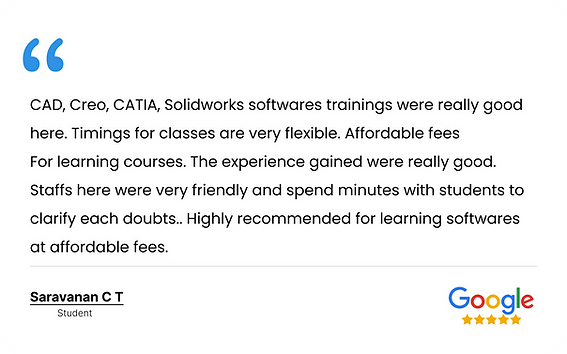top of page

Shape Your Career With The
CREO COURSE IN COIMBATORE
CREO Course Details in Coimbatore
In Coimbatore, CREO courses typically cover Computer-Aided Design (CAD) software used for product design and development. These courses offer comprehensive training in 3D modeling, drafting, assembly, and simulation. Students learn to create precise designs, analyze structures, and simulate real-world conditions. Instruction includes practical exercises, project work, and industry-relevant case studies. Emphasis is placed on enhancing proficiency in CREO Parametric, the flagship software of PTC. The curriculum often encompasses topics like part modeling, surface design, sheet metal design, and engineering drawing creation. CREO courses in Coimbatore are tailored to meet the demands of local industries and provide hands-on experience for aspiring engineers.
23,564 Total Students
4.9
(12559 Rating)
183 Reviews
What will you learning outcomes in Creo Course in Coimbatore
-
Proficiency in CREO Parametric software for product design and development.
-
3D modeling techniques for creating precise and intricate designs.
-
Drafting skills for generating accurate engineering drawings.
-
Assembly techniques to integrate multiple components into complex structures.
-
Simulation methods to analyze and optimize designs for real-world conditions.
-
Surface design principles for creating smooth and aesthetically pleasing surfaces.
-
Sheet metal design for fabricating parts with sheet metal materials.
-
Engineering drawing creation following industry standards and best practices.
-
Practical application through hands-on exercises, projects, and industry-relevant case studies.
-
Skills aligned with the demands of local industries in Coimbatore for enhanced employability.
Requirements for Creo Course in Coimbatore
-
Basic understanding of engineering principles and technical drawing concepts.
-
Familiarity with computer operations and Windows environment.
-
Access to a computer with CREO Parametric software installed (if not provided by the course).
-
Willingness to learn and engage in practical exercises.
-
Recommended: Prior experience with CAD software would be advantageous but not mandatory.
-
Access to internet connectivity for accessing course materials and resources (if applicable).

Creo Course
Duration
1 Months
Lessons
8 Modules
Languages
Tamil & English
Certificate
Yes
Software Covered
1
bottom of page











